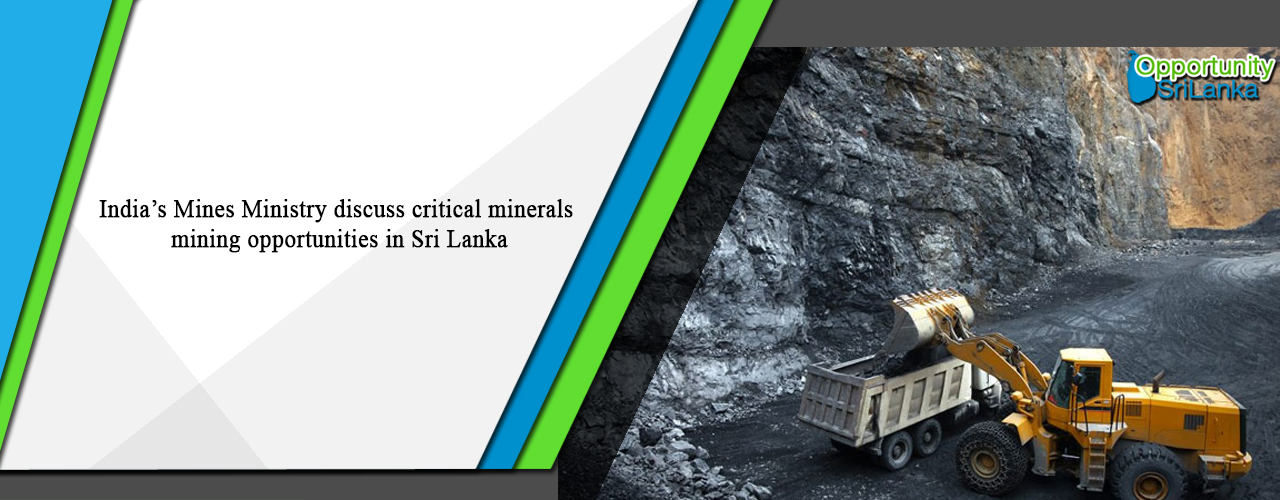India’s Mines Ministry discuss critical minerals mining opportunities in Sri Lanka
The Indian Express: India’s Ministry of Mines hosted two meetings with industry stakeholders in January to discuss opportunities for the mining of critical minerals by Indian companies in Sri Lanka and Australia. These meetings were organised in line with the ministry’s broader push to strengthen India’s critical minerals supply chain through the acquisition of overseas mineral assets.
The ministry met with representatives from companies including Ola Electric, Hindalco Industries and Gujarat Mineral Development Corporation to discuss the prospects of graphite mining in Sri Lanka on 5 January. Three days later, it organised a luncheon meeting to explore avenues for mining opportunities in Australia which was attended by the Indian High Commissioner-designate to Australia Gopal Bagley, and various industry representatives from companies including Coal India, Steel Authority of India, Vedanta, Tata Steel, Adani Group, and JSW Steel.
Sri Lanka holds significant reserves of vein graphite, a highly pure form of natural graphite that is only found on the island nation. Graphite is a critical mineral that is extensively used as the anode material in lithium-ion batteries. By weight, graphite is typically the largest component in lithium-ion batteries, with up to 70 kilograms of graphite used in an average electric vehicle (EV).
Graphite’s vital application in EVs explains the participation of Ola Electric in the ministry meeting. Ola has previously shown interest in entering the critical minerals supply chain by participating in the ministry’s ongoing first tranche of critical minerals auction. It had also attended a ministry meeting in October on opportunities in Zambia for the mining of copper, which is used as the cathode material in EV batteries.
India’s interest in Sri Lanka’s graphite coincides with the Sri Lankan Government’s active pursuit of Indian companies for graphite mining in the country. “We have the best graphite in the world. Now, Indian companies will be manufacturing electric vehicles. One of the large components for electric batteries is graphite. We used to have about 30,000 graphite mines. So there’s a lot of opportunity with the expertise and the technology these Indian companies have, I think they should seriously look at Sri Lanka,” the Sri Lankan Minister of State for Foreign Affairs Tharaka Balasuriya said in an interview to ANI on 22 February.
Graphite mining in Sri Lanka peaked during the two World Wars in the 20th century, hitting over 30,000 tonnes in annual exports. In 2023, however, the country only exported graphite weighing around 2,500 tonnes and valuing roughly $ 6 million. Sri Lanka has graphite reserves of around 1.3 million tonnes, as per data with the US Geological Survey.
Graphite in India is largely concentrated in Arunachal Pradesh, Jammu and Kashmir, and Jharkhand, with these three states collectively accounting for 74 percent of India’s graphite resources. However, only Tamil Nadu, Jharkhand, and Odisha have graphite reserves, which are measured resources that are economically viable to extract.
In the financial year 2022, India produced 57,264 tonnes of graphite and imported 54,052 tonnes from countries like China, Madagascar, and Mozambique. As per the National Mineral Inventory, India has graphite reserves of 8.56 million tonnes. In the mines ministry’s second tranche of critical minerals auction, which was announced on 29 February, 6 out of 18 blocks up for auction contain graphite, with 3 blocks each in Arunachal Pradesh and Madhya Pradesh.
The meeting on mining opportunities in Australia followed a meeting between the mine’s secretary V. L. Kantha Rao and the Australian High Commissioner to India Philip Green, on 12 December. Australia produces almost half of the world’s lithium and is the second-largest producer of cobalt. Both lithium and cobalt are used in EVs and consumer electronics.
In March, 2022, Khanij Bidesh India Limited (KABIL), a joint venture company formed by the mines ministry, and Australia’s Critical Minerals Office (CMO) signed an MoU to jointly fund mineral explorations and support potential investments by Indian companies in critical minerals projects in Australia. In March 2023, KABIL and the CMO identified 2 lithium and 3 cobalt target projects for due diligence studies, which are currently under progress.
OSL take:
Sri Lanka’s minerals industry remains an untapped business/investment opportunity. The island has many minerals from all parts of the island that have helped in the manufacturing industry as well as in the raw material exports. The many trade agreements and trade concessions enjoyed by Sri Lanka with other countries have also supported the country’s exports sector. With business, trade and investment ties between Sri Lanka and India on a steady growth path, the Indian authorities are now looking at a new business/investment opportunity in Sri Lanka’s mineral mining industry. The success of the many Indian investments in Sri Lanka have also served as confidence boosters for India to further explore opportunities in Sri Lanka. The ongoing economic activities and Sri Lanka becoming a business hub in the South Asian region have added to Sri Lanka’s attractions. Given the growing business potential in Sri Lanka, foreign businesses/investors could confidently explore the growing opportunities in the mineral mining industry.
| Article Code : | VBS/AT/20240312/Z_5 |

